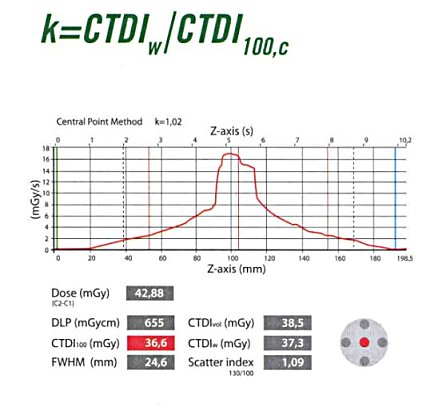

The RTI CT Dose Profiler has taken the CT quality assurance to the next level. Because of its revolutionary design it has transformed the CTDI measurement from being inaccurate due to underestimation of the dose for wide beams to be more exact. It also has the ability to further analyze the result. All in one shot.
Today computed tomography (CT) contributes up to 70% of the total dose given to patients during X-ray examinations. The rapid advancements in CT technology are placing new demands on the methods and equipment that are used for quality assurance. The wide beam widths found in CT Scanners with multiple beam apertures make it impossible to use existing CT ionization chambers to measure the total dose given to the patient. Using a Standard 10 cm CT ionization chamber may result in inaccurate measurements due to underestimation of the dose profile for wide beams. The CT Dose Profiler Probe is a new type of CT detector that does not have this limitation. It can be used with the Barracuda or the Piranha and a PC running the CT Dose Profile Analyzer Software.
The CT Dose Profiler is based on solid-state technology. 1t is robust and it fits into existing standard phantoms used for CTDI measurements. The sensitive part of the detector chip is very thin (width 0.3 mm). Thanks to the small width, the detector is completely irradiated when the table is moving and the CT scans over the probe. The dose is measured in every point of the X-ray beam and the total dose profile is acquired regardless of beam width. This makes it possibie to measure without the drawbacks of traditional CT probes.
Following Parameters are achieved from a single exposure:
The conventional method to measure CT dose profile is using TLDs. The TLD method is very time-consuming and expensive since it requires both preparation before and read-out after each scan.
Another method used today is the use of X-ray film for profile measurements that has some of the same disadvantages as the TLD. The CT Dose Profiler from RTI Electronics has no such limitations, the dose profile is given in a matter of seconds.
The Software runs on a PC connected either to a Barracuda or a Piranha. After each scan (exposure), the data is presented instantly. The detector can be used for both point dose and CTDI measurements. Examples are available for measurements on different types of CT Systems. The picture below shows a CTDI measured in a head Phantom for a nominal beam width of 20 mm and pitch 0.969.
The dose rate profile has been acquired in the central position in the phantom. The cursors are automatically placed and centered at a distance of 100 mm for the calculation of the CTDI100.
Only one exposure is needed to measure and calculate CTDI100, CTDIw, CTDIvol, DLP, FWHM and Scatter Index. To be able to simplify the procedure from normally 5 expo-sures to only one measurement in the central phantom Position (CTDI100,c), a factor k is multiplied with CTDI100,c to get the CTDIw. The k factors are stored in the existing CT Database and have been acquired from a number of different CT Systems.
In the Software, you are also able to measure the CTDIw with the five exposures at different phantom positions but is seldom needed with the new "Central Point Method".
The Software controls the Barracuda or Piranha. All settings for the meters and other pre-defined data are stored in the example files. Once a CT example has been loaded, measurement, storage and analysis of data can be done quickly for different types of CT Scanners. Measured data is saved and can be re-opened for later re-viewing. Data can also be printed or exported to Microsoft Excel for further analysis.
